3: The Globe Playhouse
( \newcommand{\kernel}{\mathrm{null}\,}\)
The following text is from a 1971 publication entitled Shakespearian Playhouses by Joseph Quincy Adams. As you read it, ask yourself what historical biases may have shaped Adams' work. What do we know now about production and theatre space that would have changed Adams' work? In what ways is Adams' work still relevant to modern historians?
CHAPTER XII
THE GLOBE
AS related more fully in the chapter on "The Theatre," when Cuthbert and Richard Burbage discovered that Gyles Alleyn not only refused to renew the lease for the land on which their playhouse stood, but was actually planning to seize the building and devote it to his private uses, they took immediate steps to thwart him. And in doing so they evolved a new and admirable scheme of theatrical management. They planned to bring together into a syndicate or stock-company some of the best actors of the day, and allow these actors to share in the ownership of the building. Hitherto playhouses had been erected merely as pecuniary investments by profit-seeking business men,—Burbage,[379] Brayne, Lanman, Henslowe, Cholmley, Langley,—and had been conducted in the interests of the proprietors rather than of the actors.[380] As a result, these proprietors had long reaped an unduly rich harvest from the efforts of the players,235 taking all or a large share of the income from the galleries. The new scheme was designed to remedy these faults.

RICHARD BURBAGE
(Reproduced by permission from a painting in the Dulwich Picture Gallery; photograph by Emery Walker, Ltd.)
For participation in this scheme the Burbages selected the following men: William Shakespeare, not only a successful actor, but a poet who had already made his reputation as a writer of plays, and who gave promise of greater attainments; John Heminges, a good actor and an exceptionally shrewd man of business, who until his death managed the pecuniary affairs of the company with distinguished success; Augustine Phillips and Thomas Pope, both ranked with the best actors of the day;[381] and William Kempe, the greatest comedian since Tarleton, described in 1600 as "a player in interludes, and partly the Queen's Majesty's jester." When to this group we add Richard Burbage himself, the Roscius of his age, we have an organization of business, histrionic, and poetic ability that could not be surpassed. It was carefully planned, and it deserved the remarkable success which it attained. The superiority of the Globe Company over all others was acknowledged in the days of James and Charles, and to-day stands out as one of the most impressive facts in the history of the early drama.
236
According to the original plan there were to be ten shares in the new enterprise, the Burbage brothers holding between them one-half the stock, or two and a half shares each, and the five actors holding the other half, or one share each. All the expenses of leasing a site, erecting a building, and subsequently operating the building as a playhouse, and likewise all the profits to accrue therefrom, were to be divided among the sharers according to their several holdings.
This organization, it should be understood, merely concerned the ownership of the building. Its members stood in the relation of landlords to the players, and were known by the technical name of "housekeepers." Wholly distinct was the organization of the players, known as the "company." The company, too, was divided into shares for the purpose of distributing its profits. The "housekeepers," in return for providing the building, received one-half of the income from the galleries; the company, for entertaining the public, received the other half of the income from the galleries, plus the takings at the doors. Those actors who were also "housekeepers" shared twice in the profits of the playhouse; and it was a part of the plan of the "housekeepers" to admit actors to be sharers in the building as soon as they attained eminence, or otherwise made their permanent connection with the playhouse desirable. Thus the two organizations, though entirely distinct, were interlocking.237
Such a scheme had many advantages. In the first place, it prevented the company from shifting from one playhouse to another, as was frequently the case with other troupes. In the second place, it guaranteed both the excellence and the permanency of the company. Too often good companies were dissolved by the desertion of a few important members; as every student of the drama knows, the constant reorganization of troupes is one of the most exasperating features of Elizabethan theatrical history. In the third place, the plan, like all profit-sharing schemes, tended to elicit from each member of the organization his best powers. The opportunity offered to a young actor ultimately to be admitted as a sharer in the ownership of the building was a constant source of inspiration,[382] and the power to admit at any time a new sharer enabled the company to recruit from other troupes brilliant actors when such appeared; as, for example, William Osteler and Nathaniel Field, who had attained fame with the Children at Blackfriars and elsewhere. Finally, the plan brought the actors together in a close bond of friendship that lasted for life. Heminges was loved and trusted by them all. Shakespeare was admired and revered; three238 members of the troupe seem to have named their sons for him. Indeed, there is nothing more inspiring in a close study of all the documents relating to the Globe than the mutual loyalty and devotion of the original sharers. The publication of Shakespeare's plays by Heminges and Condell is merely one out of many expressions of this splendid comradeship.
The plan of organization having been evolved, and the original members having been selected, the first question presenting itself was, Where should the new playhouse be erected? Burbage, Heminges, and the rest—including Shakespeare—probably gave the question much thought. Their experience in Holywell had not been pleasant; the precinct of Blackfriars, they now well realized, was out of the question; so they turned their eyes to the Bankside. That section had recently become the theatrical centre of London. There were situated the Rose, the Swan, and the Bear Garden, and thither each day thousands of persons flocked in search of entertainment. Clearly the Bankside was best suited to their purpose. Near the fine old church of St. Mary Overies, and not far from the Rose and the Bear Garden, they found a plot of land that met their approval. Its owner, Sir Nicholas Brend, was willing to lease it for a long term of years, and at a very reasonable rate. They made a verbal contract with Brend, according to which the lease was to begin on December 25, 1598.

WILLIAM SHAKESPEARE
Shakespeare seems to have been equally with Burbage a leader in erecting the Globe. In 1599 the building is officially described as "vna domo de novo edificata ... in occupacione Willielmi Shakespeare et aliorum."
239
Three days later, on December 28, Richard and Cuthbert Burbage, having secured the services of the carpenter, Peter Street, and his workmen, tore down the old Theatre and transported the timber and other materials to this new site across the river; and shortly after the Globe began to lift itself above the houses of the Bankside—a handsome theatre surpassing anything then known to London playgoers.
In the meantime the lawyers had drawn up the lease, and this was formally signed on February 21, 1599. The company had arranged a "tripartite lease," the three parties being Sir Nicholas Brend, the Burbage brothers, and the five actors.[383] To the Burbages Sir Nicholas leased one-half of the property at a yearly rental of £7 5s.; and to the five actors, he leased the other half, at the same rate. Thus the total rent paid for the land was £14 10s. The lease was to run for a period of thirty-one years.
The five actors, not satisfied with tying up the property in the "tripartite lease," proceeded at once to arrange their holdings in the form of a "joint tenancy." This they accomplished by the following device:
William Shakespeare, Augustine Phillips, Thomas Pope, John Heminges, and William Kempe did240 shortly after grant and assign all the said moiety of and in the said gardens and grounds unto William Levison and Thomas Savage, who regranted and reassigned to every one of them severally a fifth part of the said moiety of the said gardens and grounds.[384]
The object of the "joint tenancy" was to prevent any member of the organization from disposing of his share to an outsider. Legally at the death of a member his share passed into the possession of the other members, so that the last survivor would receive the whole. In reality, however, the members used the "joint tenancy" merely to control the disposition of the shares, and they always allowed the heirs-at-law to receive the share of a deceased member.
The wisdom of this arrangement was quickly shown, for "about the time of the building of said playhouse and galleries, or shortly after," William Kempe decided to withdraw from the enterprise. He had to dispose of his share to the other parties in the "joint tenancy," Shakespeare, Heminges, Phillips, and Pope, who at once divided it equally among themselves, and again went through the process necessary to place that share in "joint tenancy." After the retirement of Kempe, the organization, it will be observed, consisted of six men, and the shares were eight in number, owned241 as follows: Richard Burbage and Cuthbert Burbage, each two shares, Shakespeare, Heminges, Phillips, and Pope, each one share.
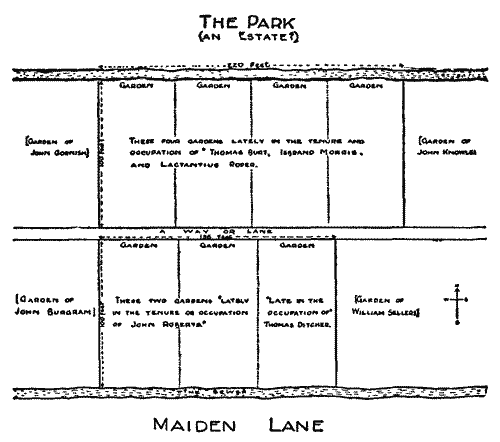
A PLAN OF THE GLOBE PROPERTY
Based on the lease and on other documents and references to the property.
[Enlarge]
The tract of land on which the new playhouse was to be erected is minutely described in the lease[385] as follows:
All that parcel of ground just recently before enclosed and made into four separate garden plots, recently in the tenure and occupation of Thomas Burt and Isbrand Morris, diers, and Lactantius Roper, salter, citizen of London, containing in length from east to west two hundred and twenty feet in assize or thereabouts, lying and adjoining upon a way or lane there on one [the south] side, and abutting upon a piece of land called The Park[386] upon the north, and upon a garden then or recently in the tenure or occupation of one John Cornishe toward the west, and upon another garden plot then or recently in the tenure or occupation of one John Knowles toward the east, with all the houses, buildings, structures, ways, easements, commodities, and appurtenances thereunto belonging.... And also all that parcel of land just recently before enclosed and made into three sep242arate garden plots, whereof two of the same [were] recently in the tenure or occupation of John Roberts, carpenter, and another recently in the occupation of one Thomas Ditcher, citizen and merchant tailor of London ... containing in length from east to west by estimation one hundred fifty and six feet of assize or thereabouts, and in breadth from the north to the south one hundred feet of assize by estimation or thereabouts, lying and adjoining upon the other side of the way or lane aforesaid, and abutting upon a garden plot there then or recently just before in the occupation of William Sellers toward the east, and243 upon one other garden plot there, then or recently just before, in the tenure of John Burgram, sadler, toward the west, and upon a lane there called Maiden Lane towards the south, with all the houses....
This document clearly states that the Globe property was situated to the north of Maiden Lane, and consequently near the river. Virtually all the contemporary maps of London show the Globe as so situated. Mr. Wallace has produced some very specific evidence to support the document cited above, and he claims to have additional evidence as yet unpublished. On the other hand, there is at least some evidence to indicate that the Globe was situated to the south of Maiden Lane.[387]
For the purposes of this book it is sufficient to know that the Globe was "situate in Maiden Lane"; whether on the north side or the south side is of less importance. More important is the nature of the site. Strype, in his edition of Stow's Survey, gives this description: "Maiden Lane, a long straggling place, with ditches on each side, the passage to the houses being over little bridges, with little garden plots before them, especially on the north side, which is best both for houses and inhabitants." In Maiden Lane, near one of these ditches or "sewers," the Globe was erected; and like the other houses there situated, it was approached over a bridge.[388] In February, 1606, the244 Sewer Commission ordered that "the owners of the playhouse called the Globe, in Maid Lane, shall before the 20 day of April next pull up and take clean out of the sewer the props or posts which stand under their bridge on the north side of Maid Lane."[389] The ground on which the building was erected was marshy, and the foundations were made by driving piles deep into the soil. Ben Jonson tersely writes:[390]
The Globe, the glory of the Bank.... Flanked with a ditch, and forced out of a marish.
Into the construction of the new playhouse went the timber and other materials secured from the old Theatre; but much new material, of course, had to be added. It is a mistake to believe that the Globe was merely the old "Theatre" newly set up on the Bankside, and perhaps strengthened here and there. When it was completed, it was regarded as the last word in theatrical architecture. Dekker seems to have had the Globe in mind in the following passage: "How wonderfully is the world altered! and no marvel, for it has lyein sick almost five thousand years: so that it is no more like the old Theater du munde, than old Paris Garden is like the King's garden at Paris. What an excellent workman therefore were he, that could cast the Globe of it into a new mould."[391] In 1600 Henslowe246 and Alleyn used the Globe as the model of their new and splendid Fortune. They sought, indeed, to show some originality by making their playhouse square instead of round; but this, the one instance in which they departed from the Globe, was a mistake; and when the Fortune was rebuilt in 1623 it was made circular in shape.
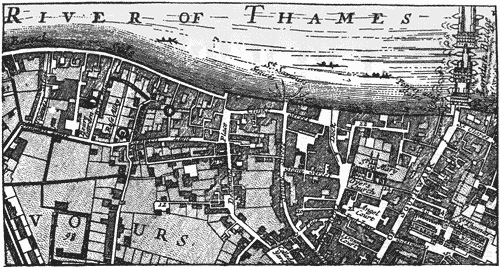
THE SITES OF THE BEAR GARDEN, THE ROSE, AND THE GLOBE
Marked by the author on a plan of the Bankside printed in Strype's Survey of London, 1720.
[Enlarge]
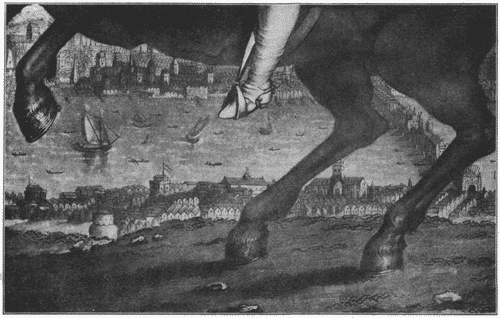
THE BEAR GARDEN, THE ROSE, AND THE FIRST GLOBE
Compare this view of the Bankside with the preceding map. (From an equestrian portrait of King James I, by Delaram. The city is represented as it was when James came to the throne in 1603.)
A few quotations from the Fortune contract will throw some light upon the Globe:
With such-like stairs, conveyances, and divisions [to the galleries], without and within, as are made and contrived in and to the late-erected playhouse ... called the Globe.
And the said stage to be in all other proportions contrived and fashioned like unto the stage of the said playhouse called the Globe.
And the said house, and other things before mentioned to be made and done, to be in all other contrivations, conveyances, fashions, thing, and things, effected, finished and done according to the manner and fashion of the said house called the Globe, saving only that all the principal and main posts ... shall be square and wrought pilasterwise, with carved proportions called satyrs to be placed and set on the top of every of the said posts.
What kind of columns were used in the Globe and how they were ornamented, we do not know, but presumably they were round. Jonson, in Every Man Out of His Humour, presented on the occasion of, or shortly after, the opening of the Globe in 1599, says of one of his characters: "A247 well-timbered fellow! he would have made a good column an he had been thought on when the house was abuilding."[392] That Jonson thought well of the new playhouse is revealed in several places; he speaks with some enthusiasm of "this fair-fitted Globe,"[393] and in the passage already quoted he calls it "the glory of the Bank."
In shape the building was unquestionably polygonal or circular, most probably polygonal on the outside and circular within. Mr. E.K. Chambers thinks it possible that it was square;[394] but there is abundant evidence to show that it was not. The very name, Globe, would hardly be suitable to a square building; Jonson describes the interior as a "round";[395] the ballad on the burning of the house refers to the roof as being "round as a tailor's clew"; and the New Globe, which certainly was not square, was erected on the old foundation.[396] The frame, we know, was of timber, and the roof248 of thatch. In front of the main door was suspended a sign of Hercules bearing the globe upon his shoulders,[397] under which was written, says Malone, the old motto, Totus mundus agit histrionem.[398]
The earliest representation of the building is probably to be found in the Delaram View of London (opposite page 246), set in the background of an engraving of King James on horseback. This view, which presents the city as it was in 1603 when James came to the throne, shows the Bear Garden at the left, polygonal in shape, the Rose in the centre, circular in shape, and the Globe at the right, polygonal in shape. It is again represented in Visscher's magnificent View of London, which, though printed in 1616, presents the city as it was several years earlier (see page 253). The Merian View of 1638 (opposite page 256) is copied from Visscher, and the View in Howell's Londinopolis (1657) is merely a slavish copy of Merian; these two views, therefore, so far as the Globe is concerned, have no special value.[399]
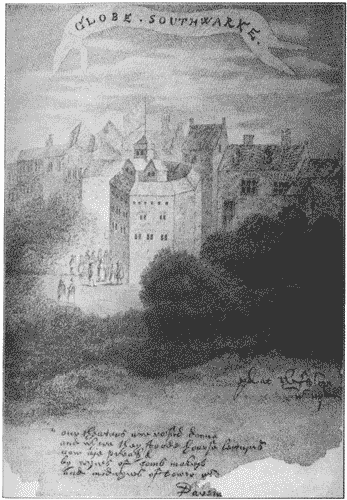
THE FIRST GLOBE
From an old drawing in an extra-illustrated copy of Pennant's London now in the British Museum. Apparently the drawing is based on Visscher's View.
The cost of the finished building is not exactly known. Mr. Wallace observes that it was erected249 "at an original cost, according to a later statement, of £600, but upon better evidence approximately £400."[400] I am not aware of the "better evidence" to which Mr. Wallace refers,[401] nor do I know whether the estimate of £400 includes the timber and materials of the old Theatre furnished by the Burbages. If the Theatre of 1576 cost nearly £700, and the second Globe cost £1400, the sum of £400 seems too small.
Nor do we know exactly when the Globe was finished and opened to the public. On May 16, 1599, a post-mortem inquisition of the estate of Sir Thomas Brend, father of Sir Nicholas, was taken. Among his other properties in Southwark was listed the Globe playhouse, described as "vna domo de novo edificata ... in occupacione Willielmi Shakespeare et aliorum."[402] From this statement Mr. Wallace infers that the Globe was finished and opened before May 16, 1599. Though this is possible, the words used seem hardly to warrant the conclusion. However, we may feel sure that the actors, the Lord Chamberlain's Men, had moved into the building before the end of the summer.
Almost at once they rose to the position of leadership in the drama, for both Shakespeare and Burbage were now at the height of their powers. It is true that in 1601 the popularity of the Chil250dren at Blackfriars, and the subsequent "War of the Theatres" interfered somewhat with their success; but the interference was temporary, and from this time on until the closing of the playhouses in 1642, the supremacy of the Globe players was never really challenged. When James came to the throne, he recognized this supremacy by taking them under his royal patronage. On May 19, 1603, he issued to them a patent to play as the King's Men[403]—an honor that was as well deserved as it was signal.
In the autumn of 1608 the proprietors of the Globe acquired the Blackfriars Theatre for the use of their company during the severe winter months. This splendid building, situated in the very heart of the city, was entirely roofed in, and could be comfortably heated in cold weather. Henceforth the open-air Globe was used only during the pleasant season of the year; that is, according to the evidence of the Herbert Manuscript, from about the first of May until the first of November.
On June 29, 1613, the Globe caught fire during the performance of a play, and was burned to the ground—the first disaster of the sort recorded in English theatrical history. The event aroused great interest in London, and as a result we have numerous accounts of the catastrophe supplying us with full details. We learn that on a warm "sunne-shine" afternoon the large building was "filled251 with people"—among whom were Ben Jonson, John Taylor (the Water-Poet), and Sir Henry Wotton—to witness a new play by William Shakespeare and John Fletcher, called All is True, or, as we now know it, Henry VIII, produced with unusual magnificence. Upon the entrance of the King in the fourth scene of the first act, two cannon were discharged in a royal salute. One of the cannon hurled a bit of its wadding upon the roof and set fire to the thatch; but persons in the audience were so interested in the play that for a time they paid no attention to the fire overhead. As a result they were soon fleeing for their lives; and within "one short hour" nothing was left of the "stately" Globe.
I quote below some of the more interesting contemporary accounts of this notable event. Howes, the chronicler, thus records the fact in his continuation of Stow's Annals:
Upon St. Peter's Day last, the playhouse or theatre called the Globe, upon the Bankside, near London, by negligent discharge of a peal of ordnance, close to the south side thereof, the thatch took fire, and the wind suddenly dispersed the flames round about, and in a very short space the whole building was quite consumed; and no man hurt: the house being filled with people to behold the play, viz. of Henry the Eight.[404]
Sir Henry Wotton, in a letter to a friend, gives the following gossipy account:252
Now to let matters of state sleep. I will entertain you at the present with what happened this week at the Bankside. The King's Players had a new play, called All is True, representing some principal pieces of the reign of Henry the Eighth, which was set forth with many extraordinary circumstances of pomp and majesty, even to the matting of the stage; the Knights of the Order with their Georges and Garter, the guards with their embroidered coats, and the like—sufficient in truth within awhile to make greatness very familiar, if not ridiculous. Now King Henry, making a masque at the Cardinal Wolsey's house, and certain cannons being shot off at his entry, some of the paper or other stuff wherewith one of them was stopped, did light on the thatch, where being thought at first but an idle smoke, and their eyes more attentive to the show, it kindled inwardly, and ran round like a train, consuming within less than an hour the whole house to the very ground. This was the fatal period of that virtuous fabrick; wherein yet nothing did perish but wood and straw, and a few forsaken cloaks; only one man had his breeches set on fire, that would perhaps have broiled him, if he had not, by the benefit of a provident wit, put it out with bottle ale.[405]
John Chamberlain, writing to Sir Ralph Winwood, July 8, 1613, refers to the accident thus:
The burning of the Globe or playhouse on the Bankside on St. Peter's Day cannot escape you; which fell out by a peal of chambers (that I know not upon what occasion were to be used in the play), the tampin or stopple of one of them lighting in the thatch that cover'd the house, burn'd it down to the253 ground in less than two hours, with a dwelling house adjoining; and it was a great marvel and fair grace of God that the people had so little harm, having but two narrow doors to get out.[406]
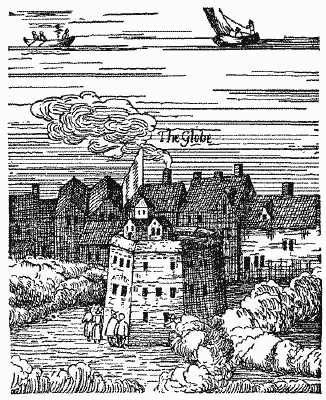
THE FIRST GLOBE
From Visscher's View of London, published in 1616, but representing the city as it was several years earlier.
254The Reverend Thomas Lorkin writes from London to Sir Thomas Puckering under the date of June 30, 1613:
No longer since than yesterday, while Burbage's company were acting at the Globe the play of Henry VIII, and there shooting off certain chambers in way of triumph, the fire catched and fastened upon the thatch of the house, and there burned so furiously, as it consumed the whole house, all in less than two hours, the people having enough to do to save themselves.[407]
A contemporary ballad[408] gives a vivid and amusing account of the disaster:
A Sonnet upon the Pitiful Burning of the Globe
Playhouse in London
Now sit thee down, Melpomene,
Wrapt in a sea-coal robe,
And tell the dolefull tragedy
That late was played at Globe;
For no man that can sing and say
Was scared on St. Peter's day.
Oh sorrow, pitiful sorrow, and yet all this is true.[409]
All you that please to understand,
Come listen to my story;
To see Death with his raking brand
255Mongst such an auditory;
Regarding neither Cardinall's might,
Nor yet the rugged face of Henry the eight.
Oh sorrow, etc.
This fearful fire began above,
A wonder strange and true,
And to the stage-house did remove,
As round as taylor's clew,
And burnt down both beam and snagg,
And did not spare the silken flagg.
Oh sorrow, etc.
Out run the Knights, out run the lords,
And there was great ado;
Some lost their hats, and some their swords;
Then out run Burbage, too.
The reprobates, though drunk on Monday,
Prayd for the fool and Henry Condy.
Oh sorrow, etc.
The periwigs and drum-heads fry
Like to a butter firkin;
A woeful burning did betide
To many a good buff jerkin.
Then with swolen eyes, like drunken Flemminges
Distressed stood old stuttering Heminges.
Oh sorrow, etc.
Ben Jonson, who saw the disaster, left us the following brief account:
The Globe, the glory of the Bank,
Which, though it were the fort of the whole parish,
Flanked with a ditch, and forced out of a marish,
I saw with two poor chambers taken in,
And razed ere thought could urge this might have been!
See the world's ruins! nothing but the piles
Left—and wit since to cover it with tiles.[410]
256
The players were not seriously inconvenienced, for they could shift to their other house, the Blackfriars, in the city. The owners of the building, however, suffered a not inconsiderable pecuniary loss. For a time they hesitated about rebuilding, one cause of their hesitation being the short term that their lease of the ground had to run. Possibly a second cause was a doubt as to the ownership of the ground, arising from certain transactions recorded below. In October, 1600, Sir Nicholas Brend had been forced to transfer the Globe estate, with other adjacent property, to Sir Matthew Brown and John Collett as security for a debt of £2500; and a few days after he died. Since the son and heir, Matthew Brend, was a child less than two years old, an uncle, Sir John Bodley, was appointed trustee. In 1608 Bodley, by unfair means, it seems, purchased from Collett the Globe property, and thus became the landlord of the actors. But young Matthew Brend was still under age, and Bodley's title to the property was not regarded as above suspicion.[411]
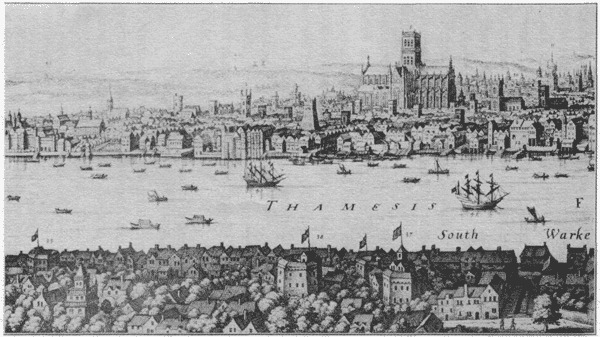
MERIAN'S VIEW OF LONDON
A section from Merian's View, showing the Bankside playhouses. This View, printed in Ludvig Gottfried's Neuwe Archontologia Cosmica (Frankfurt am Mayn, 1638), represents London as it was about the year 1612, and was mainly based on Visscher's View, with some additions from other sources.
Four months after the burning of the Globe, on October 26, 1613, Sir John Bodley granted the proprietors of the building a renewal of the lease with an extension of the term until December 25, 1635.[412] But a lease from Bodley alone, in view of257 the facts just indicated, was not deemed sufficient; so on February 14, 1614, Heminges, the two Burbages, and Condell visited the country-seat of the Brends, and secured the signature of the young Matthew Brend, and of his mother as guardian, to a lease of the Globe site with a term ending on December 25, 1644.
Protected by these two leases, the Globe sharers felt secure; and they went forward apace with the erection of their new playhouse. They made an assessment of "£50 or £60" upon each share.[413] Since at this time there were fourteen shares, the amount thus raised was £700 or £840. This would probably be enough to erect a building as large and as well equipped as the old Globe. But the proprietors determined upon a larger and a very much handsomer building. As Howes, the continuer of Stow's Annals, writes, "it was new builded in far fairer manner than before"; or as John Taylor, the Water-Poet, puts it:
As gold is better that's in fire tried,
So is the Bankside Globe that late was burn'd.[414]
Naturally the cost of rebuilding exceeded the original estimate. Heminges tells us that on one share, or one-fourteenth, he was required to pay for "the re-edifying about the sum of £120."[415]258 This would indicate a total cost of "about" £1680. Heminges should know, for he was the business manager of the organization; and his truthfulness cannot be questioned. Since, however, the adjective "about," especially when multiplied by fourteen, leaves a generous margin of uncertainty, it is gratifying to have a specific statement from one of the sharers in 1635 that the owners had "been at the charge of £1400 in building of the said house upon the burning down of the former."[416] Heminges tells us that "he found that the re-edifying of the said playhouse would be a very great charge," and that he so "doubted what benefit would arise thereby" that he actually gave away half of one share "to Henry Condell, gratis."[417] But his fears were unfounded. We learn from Witter that after the rebuilding of the Globe the "yearly value" of a share was greater "by much" than it had been before.[418]
259
The New Globe, like its predecessor, was built of timber,[419] and on the same site—indeed the carpenters made use of the old foundation, which seems not to have been seriously injured. In a "return" of 1634, preserved at St. Saviour's, we read: "The Globe playhouse, near Maid Lane, built by the company of players, with a dwelling house thereto adjoining, built with timber, about 20 years past, upon an old foundation."[420] In spite of the use made of the old foundation, the new structure was unquestionably larger than the First Globe; Marmion, in the Prologue to Holland's Leaguer, acted at Salisbury Court in 1634, speaks of "the vastness of the Globe," and Shirley, in the Prologue to Rosania, applies the adjective "vast" to the building. Moreover, the builders had "the wit," as Jonson tells us, "to cover it with tiles." John Taylor, the Water-Poet, writes:
For where before it had a thatched hide,
Now to a stately theatre is turn'd.
The Second Globe is represented, but unsatisfactorily, in Hollar's View of London, dated 1647 (opposite page 260). It should be noted that the artist was in banishment from 1643 (at which260 time the Globe was still standing) until 1652, and hence, in drawing certain buildings, especially those not reproduced in earlier views of London, he may have had to rely upon his memory. This would explain the general vagueness of his representation of the Globe.
The construction was not hurried, for the players had Blackfriars as a home. Under normal conditions they did not move from the city to the Bankside until some time in May; and shortly after that date, in the early summer of 1614, the New Globe was ready for them. John Chamberlain writes to Mrs. Alice Carleton on June 30, 1614:
I have not seen your sister Williams since I came to town, though I have been there twice. The first time she was at a neighbor's house at cards, and the next she was gone to the New Globe to a play. Indeed, I hear much speech of this new playhouse, which is said to be the fairest that ever was in England.[421]
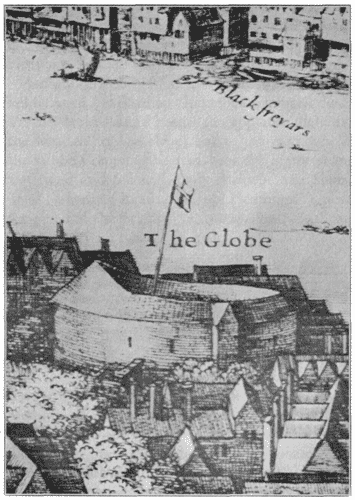
THE SECOND GLOBE
From Hollar's View of London (1647).
With this New Globe Shakespeare had little to do, for his career as a playwright had been run, and probably he had already retired from acting. Time, indeed, was beginning to thin out the little band of friends who had initiated and made famous the Globe organization. Thomas Pope had died in 1603, Augustine Phillips in 1605, William Slye in 1608, and, just a few months after the opening of the new playhouse, William Osteler, who had been261 admitted to the partnership in 1611. He had begun his career as a child-actor at Blackfriars, had later joined the King's Men, and had married Heminges's daughter Thomasine.
A more serious blow to the company, however, fell in April, 1616, when Shakespeare himself died. To the world he had been "the applause, delight, the wonder" of the stage; but to the members of the Globe Company he had been for many years a "friend and fellow." Only Burbage and Heminges (described in 1614 as "old Heminges"), now remained of the original venturers. And Burbage passed away on March 13, 1619:
He's gone! and with him what a world are dead
Which he reviv'd—to be revived so
No more. Young Hamlet, old Hieronimo,
Kind Lear, the grieved Moor, and more beside
That lived in him have now for ever died![422]
Many elegies in a similar vein were written celebrating his wonderful powers as an actor; yet the tribute that perhaps affects us most deals with him merely as a man. The Earl of Pembroke, writing to the Ambassador to Germany, gives the court news about the mighty ones of the kingdom: "My Lord of Lenox made a great supper to the French Ambassador this night here, and even now all the company are at a play; which I, being tender-262hearted, could not endure to see so soon after the loss of my old acquaintance Burbage."[423]
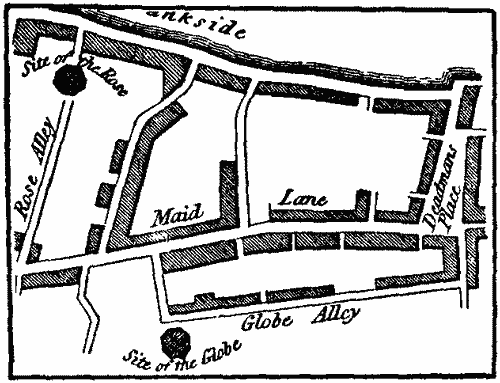
THE TRADITIONAL SITE OF THE GLOBE
From Wilkinson's Theatrum Illustrata (1825). This site is still advocated by some scholars. Compare page 245.
In 1623 Heminges and Condell, with great "care and paine," collected and published the plays of Shakespeare, "onely to keep the memory of so worthy a Friend and Fellow alive"; and shortly after, they too died, Condell in 1627 and Heminges in 1630.
After the passing of this group of men, whose names are so familiar to us, the history of the playhouse seems less important, and may be chronicled briefly.
When young Matthew Brend came of age he recovered possession of the Globe property by a decree of the Court of Wards. Apparently he accepted the lease executed by his uncle and guardian, Bodley, by which the actors were to remain in possession of the Globe until December 25, 1635; but in 1633 he sought to cancel the lease he himself had executed as a minor, by which the actors were to remain in possession until 1644. His purpose in263 thus seeking to gain possession of the Globe was to lease it to other actors at a material increase in his profits.[424] Naturally the owners of the Globe were alarmed, and they brought suit in the Court of Requests. In 1635, one of the sharers, John Shanks, declares that he "is without any hope to renew" the lease; and he refers thus to the suit against Brend: "When your suppliant purchased his parts [in 1634] he had no certainty thereof more than for one year in the Globe, and there was a chargeable suit then pending in the Court of Requests between Sir Mathew Brend, Knight, and the lessees of the Globe and their assigns, for the adding of nine years to their lease in consideration that their predecessors had formerly been at the charge of £1400 in building of the said house."[425] The lessees ultimately won their contention, and thus secured the right to occupy the Globe until December 25, 1644—a term which, as it happened, was quite long enough, for the Puritans closed all playhouses in 1642.
What disposition, if any, the sharers made of the Globe between 1642 and 1644 we do not know. But before the lease expired, it seems, Brend demolished the playhouse and erected tenements on264 its site. In the manuscript notes to the Phillipps copy of Stow's Annals, we find the statement that the Globe was "pulled down to the ground by Sir Mathew Brend, on Monday the 15 of April, 1644, to make tenements in the room of it";[426] and the statement is verified by a mortgage, executed in 1706, between Elizabeth, the surviving daughter and heir of Thomas Brend, and one William James, citizen of London. The mortgage concerns "all those messuages or tenements ... most of which ... were erected and built where the late playhouse called the Globe stood, and upon the ground thereunto belonging."[427]
After this the history of the property becomes obscure. Mrs. Thrale (later Mrs. Piozzi), the friend of Samuel Johnson, whose residence was near by in Deadman's Place, thought that she saw certain "remains of the Globe" discovered by workmen in the employ of her husband:[428] "For a long time, then,—or I thought it such,—my fate was bound up with the old Globe Theatre, upon the Bankside, Southwark; the alley it had occupied having been purchased and [the tenements] thrown down by Mr. Thrale to make an opening before the windows of our dwelling-house. When it lay desolate in a black heap of rubbish, my mother one day in a265 joke called it the Ruins of Palmyra; and after that they had laid it down in a grass-plot Palmyra was the name it went by.... But there were really curious remains of the old Globe Playhouse, which though hexagonal in form without, was round within." In spite of serious difficulties in this narrative it is possible that the workmen, in digging the ground preparatory to laying out the garden, uncovered the foundation of the Globe, which, it will be recalled, was formed of piles driven deep into the soil, and so well made that it resisted the fire of 1613.[429]
At the present time the site of the Globe is covered by the extensive brewery of Messrs. Barclay, Perkins, and Company. Upon one of the walls of the brewery, on the south side of Park Street, which was formerly Maiden Lane, has been placed a bronze memorial tablet[430] showing in relief the Bankside, with what is intended to be the Globe Playhouse conspicuously displayed in the foreground. This is a circular building designed after the circular playhouse in the Speed-Hondius View of London, and represents, as I have tried to show, not the Globe, but the Rose. At the left side of266 the tablet is a bust of the poet modeled after the Droeshout portrait. At the right is the simple inscription:
HERE STOOD THE GLOBE PLAYHOUSE OF
SHAKESPEARE
Yet it is very doubtful whether the Globe really stood there. Mr. Wallace has produced good evidence to show that the building was on the north side of Park Street near the river; and in the course of the present study I have found that site generally confirmed.

